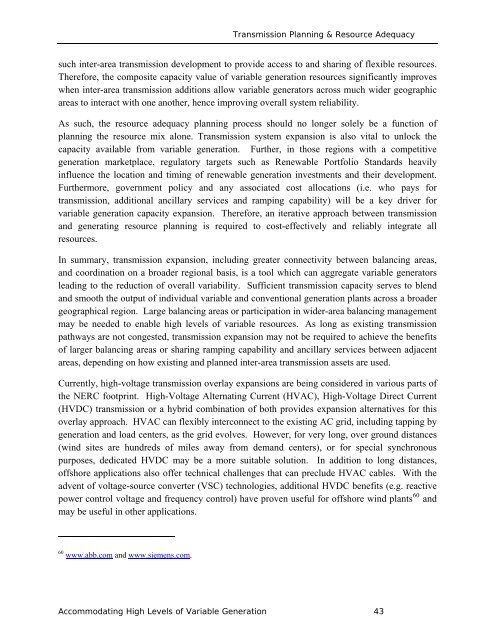Accommodating High Levels of Variable Generation - NERC
Accommodating High Levels of Variable Generation - NERC
Accommodating High Levels of Variable Generation - NERC
You also want an ePaper? Increase the reach of your titles
YUMPU automatically turns print PDFs into web optimized ePapers that Google loves.
Transmission Planning & Resource Adequacy<br />
such inter-area transmission development to provide access to and sharing <strong>of</strong> flexible resources.<br />
Therefore, the composite capacity value <strong>of</strong> variable generation resources significantly improves<br />
when inter-area transmission additions allow variable generators across much wider geographic<br />
areas to interact with one another, hence improving overall system reliability.<br />
As such, the resource adequacy planning process should no longer solely be a function <strong>of</strong><br />
planning the resource mix alone. Transmission system expansion is also vital to unlock the<br />
capacity available from variable generation. Further, in those regions with a competitive<br />
generation marketplace, regulatory targets such as Renewable Portfolio Standards heavily<br />
influence the location and timing <strong>of</strong> renewable generation investments and their development.<br />
Furthermore, government policy and any associated cost allocations (i.e. who pays for<br />
transmission, additional ancillary services and ramping capability) will be a key driver for<br />
variable generation capacity expansion. Therefore, an iterative approach between transmission<br />
and generating resource planning is required to cost-effectively and reliably integrate all<br />
resources.<br />
In summary, transmission expansion, including greater connectivity between balancing areas,<br />
and coordination on a broader regional basis, is a tool which can aggregate variable generators<br />
leading to the reduction <strong>of</strong> overall variability. Sufficient transmission capacity serves to blend<br />
and smooth the output <strong>of</strong> individual variable and conventional generation plants across a broader<br />
geographical region. Large balancing areas or participation in wider-area balancing management<br />
may be needed to enable high levels <strong>of</strong> variable resources. As long as existing transmission<br />
pathways are not congested, transmission expansion may not be required to achieve the benefits<br />
<strong>of</strong> larger balancing areas or sharing ramping capability and ancillary services between adjacent<br />
areas, depending on how existing and planned inter-area transmission assets are used.<br />
Currently, high-voltage transmission overlay expansions are being considered in various parts <strong>of</strong><br />
the <strong>NERC</strong> footprint. <strong>High</strong>-Voltage Alternating Current (HVAC), <strong>High</strong>-Voltage Direct Current<br />
(HVDC) transmission or a hybrid combination <strong>of</strong> both provides expansion alternatives for this<br />
overlay approach. HVAC can flexibly interconnect to the existing AC grid, including tapping by<br />
generation and load centers, as the grid evolves. However, for very long, over ground distances<br />
(wind sites are hundreds <strong>of</strong> miles away from demand centers), or for special synchronous<br />
purposes, dedicated HVDC may be a more suitable solution. In addition to long distances,<br />
<strong>of</strong>fshore applications also <strong>of</strong>fer technical challenges that can preclude HVAC cables. With the<br />
advent <strong>of</strong> voltage-source converter (VSC) technologies, additional HVDC benefits (e.g. reactive<br />
power control voltage and frequency control) have proven useful for <strong>of</strong>fshore wind plants 60 and<br />
may be useful in other applications.<br />
60 www.abb.com and www.siemens.com.<br />
<strong>Accommodating</strong> <strong>High</strong> <strong>Levels</strong> <strong>of</strong> <strong>Variable</strong> <strong>Generation</strong> 43
















